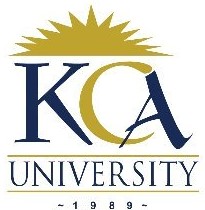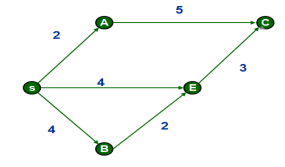 UNIVERSITY EXAMINATIONS: 2018/2019
UNIVERSITY EXAMINATIONS: 2018/2019
EXAMINATION FOR THE DEGREE OF BACHELOR OF SCIENCE IN
INFORMATION TECHNOLOGY/ BACHELOR OF BUSINESS IN
INFORMATION TECHNOLOGY
BIT 2103: PRINCIPLES OF ARTIFICIAL INTELLIGENCE
/FOUNDATIONS OF ARTIFICIAL INTELLIGENCE
FULL TIME/PART TIME/DISTANCE LEARNING
DATE: DECEMBER, 2018 TIME: 2 HOURS
INSTRUCTIONS: Answer Question One & ANY OTHER TWO questions.
QUESTION ONE (COMPULSORY) [30 MARKS].
(a). Briefly explain the meaning of the following concepts. Use an example to illustrate your
answer for each concept.
(i) Artificial intelligence (2 Marks)
(ii) Intelligent agent (2 Marks)
(iii) Inference (2 Marks)
(b). Explain four differences between intelligent agents and other convectional softwares.
(4 Marks)
(c) Briefly explain the meaning of the following concepts with reference to artificial intelligence
i) Forward chain reasoning (2 Marks)
ii) Spatial intelligence (2 Marks)
(d) Distinguish between Musical and bodily kinesthetic intelligence. State potential careers and
techniques used for improving each intelligence (4 Marks)
(e) Write whether each statement is true (T) or false (F), and provide a short explanation:
( i) greedy search and hill climbing search are inefficient (2 Marks)
(ii) Breadth first search is optimal (2 Marks)
(iii) Uniform cost search is complete (2 Marks)
(f) Briefly explain three assumptions of artificial intelligence (3 Marks).
(g) Briefly explain three types of intelligent agents (3 Marks).
QUESTION TWO [20 MARKS]
(a) Describe two limitations of depth first search (2 Marks).
(b) Explain four characteristics of un informed searching methods (4 Marks)
(c) Briefly describe the meaning of the term “search problem” (1 Mark)
(d).State and explain five elements of defining search problem. (5 Marks)
(e). Consider the search tree shown Figure below.

(i)Use depth first search algorithm to find a path from S to E. What is the path cost?
(4 Marks)
(ii) Use breadth first algorithm find a path from S to C. Specify the path cost (4 Marks)
QUESTION THREE [20 MARKS]
(a) Describe five properties of a good knowledge representation technique (5 Marks).
(b) Translate the following statements into predicate logic.
(i) all men are mortal (2 Marks).
(ii) Everything in the garden is lovely (2 Marks).
(iii) John and Ann are married (2 Marks).
(c) Use Sematic network to represent the following predicate logic statement. (3 Marks)
isa(person,mammal), instance(Mike-Hall, person), team(Mike-
Hall,Cardiff), has_part(person,head), team_colours(Cardiff,blue/black)
(d) Construct Semantic Net representations of the following sentence: (3 Marks)
Dave is Kenyan and he is a lecturer. Lecturers teach in a university
(e) Translate the following predicate logic into a frame. (3 Marks)
Gender(Adam,Male),spouse(Adam,Beth), child (Adam,Charles), child(Adam,Donna)
child(Adam,Ellen)
QUESTION FOUR [20 MARKS]
(a) Briefly explain three goals of inference. (3 Marks).
(b) Explain the differences between the following inferencing methods. Use an example to
illustrate your answer in each case.
(i). Deductive and inductive Inferencing (4 Marks).
(ii). Fuzzy logic inferencing and case-based inferencing. (4 Marks).
(c) Briefly explain seven components of an expert system (7 Marks)
(d) Define the term “ heuristics” as used in artificial intelligence (2 Marks)
QUESTION FIVE [20 MARKS]
(a) State and explain any four types of agents’ environments that interact with intelligent agents
(4 Marks).
(b) Briefly explain the following components of an agent. Give one example to illustrate your
answer.
i) Sensor (2 Marks)
ii) Actuator (2 Marks)
ii) Agent function (2 Marks)
(c) Consider the following knowledgebase of a certain family
father_of (peter, fred) .
father_of (peter, tom).
father_of (james,david).
gender (tom, male)
student (tom, KCAU).
Formulate predicate- logic queries that can be typed in Prolog to find the following
knowledge
(i) a list of all the fathers (2 Marks)
(ii) all the children of peter. (2 Marks)
(v) Confirm the existence of a kcau student known as tom (2 Marks)
(d) Explain any two applications of intelligent agents in business enterprises (4 Marks)
